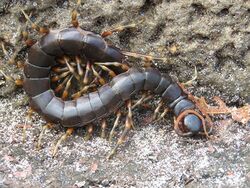Biology:Scolopendra galapagoensis
| Scolopendra galapagoensis | |
|---|---|

| |
| Scientific classification | |
| Domain: | Eukaryota |
| Kingdom: | Animalia |
| Phylum: | Arthropoda |
| Subphylum: | Myriapoda |
| Class: | Chilopoda |
| Order: | Scolopendromorpha |
| Family: | Scolopendridae |
| Genus: | Scolopendra |
| Species: | S. galapagoensis
|
| Binomial name | |
| Scolopendra galapagoensis Bollmann, 1889
| |
| Synonyms[1][2] | |
|
Scolopendra gigentea weyrauchi (Bücherl, 1950) | |
Scolopendra galapagoensis, also known as the Galápagos centipede[3][4] and Darwin's goliath centipede,[5][6] is species of very large centipede in the family Scolopendridae.[7] It is the only representative of the genus Scolopendra on the Galapagos Islands, among twelve other species of centipede present on the Islands.[8][9] It is also found on mainland South America in Ecuador and Peru, and on Cocos Island in Costa Rica.[9][8]
Appearance
The Galápagos Centipede is one of the largest species of centipede in the world. Specimens have been recorded with lengths up to 30 cm.[9][6]
Colour morphs
Scolopendra galapagoensis exhibits three colour morphs:[6]
| # | Body | Legs | Notes |
|---|---|---|---|
| 1 | Dark green to black | Striped, Orange to dark brown | This is called the 'Dark Morph' among pet enthusiasts[6]
See speciesbox photo |
| 2 | Orange-red | Pale Yellow | This appears to be called the 'Orange Morph' among pet enthusiasts[6] |
Diet and predation
S. galapagoensis has been reported preying on crickets, newborn rodents, the Galapagos Rice Rat, and, in one paper, a Floreana Racer snake.[6] It is hunted by a variety of birds of prey including the Galapagos hawk, two species of mockingbird, and the common Black Rat.[9]
References
- ↑ "The Myriapoda of the Galápagos Archipelago, Ecuador (Chilopoda, Diplopoda, Symphyla)". Belgian Journal of Entomology. https://www.researchgate.net/publication/267153523.
- ↑ Shelley, R. M.; Kiser, S. B. (May 1, 2000). "Neotype designation and a diagnostic account for the centipede, Scolopendra gigantea L. 1758, with an account of S. galapagoensis Bollman 1889 (Chilopoda Scolopendromorpha Scolopendridae)". Tropical Zoology 13 (1): 159–170. doi:10.1080/03946975.2000.10531129. https://doi.org/10.1080/03946975.2000.10531129.
- ↑ "Galapagos Species Checklist" (in en-gb). https://www.darwinfoundation.org/en/datazone/checklist.
- ↑ "Galápagos Centipede (Scolopendra galapagoensis)" (in en). https://www.inaturalist.org/taxa/196398-Scolopendra-galapagoensis.
- ↑ Dunlap, Sadie (2021-10-11). "The 10 Biggest Centipedes in the World!" (in en-US). https://a-z-animals.com/blog/the-10-biggest-centipedes-in-the-world/.
- ↑ 6.0 6.1 6.2 6.3 6.4 6.5 Jake (2022-07-30). "Different Types of Centipedes with Pictures" (in en-US). https://pestbugs.org/centipedes/types-pictures/.
- ↑ "Scolopendra galapagoensis Bollman, 1889" (in en). https://www.gbif.org/species/5179548.
- ↑ 8.0 8.1 Baert, Léon; Herrera, Henri W. (2013). "The Myriapoda of the Galápagos Archipelago, Ecuador (Chilopoda, Diplopoda, Symphyla)". Belgian Journal of Entomology 1 (49). https://www.researchgate.net/publication/267153523.
- ↑ 9.0 9.1 9.2 9.3 Ortiz-Catedral, Luis; Christian, Eli; Chimborazo, Walter; Sevilla, Christian; Rueda, Danny. "A Galapagos Centipede Scolopendra Galapagoensis Preys On A Floreana Racer Pseudalsophis Biserialis". Galapagos Research 70: 2,3. https://www.researchgate.net/publication/351076563.
Further reading & external links
- Neotype designation and a diagnostic account for the centipede, Scolopendra gigantea L. 1758,with an account of S. galapagoensis Bollman 1889
- Scolopendra galapagoensis - Charles Darwin Foundation
- YouTube- Scolopendra galapagoensis (Orange Morph) behaviour in enclosure
Wikidata ☰ Q6509777 entry

